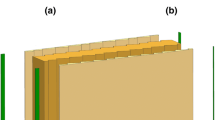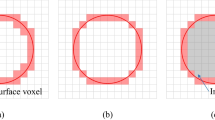Abstract
This paper presents an efficient method of computing machined part geometry in general multi-axis milling. The method is based on the frame-sliced voxel representation of the workpiece geometry and involves a three-step update process. Virtual prototyping of the machined part geometry is useful for tool path verification and demands fast computations for quick feedback. The frame-sliced voxel representation (FSV-rep) model retains the advantages of efficiency and robustness of voxel modeling in model update along with the accuracy and boundary representation quality comparable to that of triangle meshing. The multi-level FSV-rep model allows a three-step update process of the model, which enables batch processing of the voxels and minimal intersection calculations to achieve fast and accurate modeling results. In a series of test cases, the FSV-rep-based computation has shown up to 3.3 times faster performance compared to that of the existing tri-dexel-based method with similar modeling accuracy. The better performance of the present method is attributed to the bulk workpiece volume to be removed and the complex multi-axis motions of the cutting tool with tilted orientations.
Similar content being viewed by others
References
Altintas Y (2012) Manufacturing automation: metal cutting mechanics, machine tool vibrations, and CNC design, 2nd edn. Cambridge University Press, Cambridge
Zhang Y, Xu X, Liu Y (2011) Numerical control machining simulation: a comprehensive survey. Int J Comput Integr Manuf 24:593–609
Oliver JH, Goodman ED (1990) Direct dimensional NC verification. Comput Aided Des 22:3–9
OuYang D, Feng HY, Van Nest BA, Buchal RO (2009) Effective gouge-free tool selection for free-form surface machining. Comput-Aided Des Appl 6:839–849
Du J, Yan X, Tian X (2012) The avoidance of cutter gouging in five-axis machining with a fillet-end milling cutter. Int J Adv Manuf Technol 62:89–97
Ding S, Mannan MA, Poo AN (2004) Oriented bounding box and octree based global interference detection in 5-axis machining of free-form surfaces. Comput Aided Des 36:1281–1294
Ilushin O, Elber G, Halperin D, Wein R, Kim M (2005) Precise global collision detection in multi-axis NC-machining. Comput Aided Des 37:909–920
Lee YS, Chang TC (1995) 2-phase approach to global tool interference avoidance in 5-axis machining. Comput Aided Des 27:715–729
Erkorkmaz K, Altintas Y, Yeung CH (2006) Virtual computer numerical control system. CIRP Ann Manuf Technol 55:399–402
Merdol SD, Altintas Y (2008) Virtual cutting and optimization of three-axis milling processes. Int J Mach Tools Manuf 48:1063–1071
Yousefian O, Tarbutton JA (2015) Prediction of cutting force in 3-axis CNC milling machines based on voxelization framework for digital manufacturing. Procedia Manuf 1:512–521
Ong SK, Yuan ML, Nee AYC (2008) Augmented reality applications in manufacturing: a survey. Int J Prod Res 46:2707–2742
Mujber TS, Szecsi T, Hashmi MSJ (2004) Virtual reality applications in manufacturing process simulation. J Mater Process Technol 155-156:1834–1838
Joy J, Feng HY (2016) Frame-sliced voxel representation: an accurate and memory-efficient modeling method for workpiece geometry in machining simulation. Comput Aided Des (accepted)
Spence AD, Abrari F, Elbestawi MA (2000) Integrated solid modeller based solutions for machining. Comput Aided Des 32:553–568
El-Mounayri H, Elbestawi MA, Spence AD, Bedi S (1997) General geometric modelling approach for machining process simulation. Int J Adv Manuf Technol 13:237–247
Aras E, Yip-Hoi D (2008) Geometric modeling of cutter/workpiece engagements in three-axis milling using polyhedral representations. ASME J Comput Inf Sci Eng 8:031007
Gong X, Feng HY (2016) Cutter-workpiece engagement determination for general milling using triangle mesh modeling. J Comput Des Eng 3:151–160
Roy U, Xu Y (1999) Computation of a geometric model of a machined part from its NC machining programs. Comput Aided Des 31:401–411
Fussell BK, Jerard RB, Hemmett JG (2003) Modeling of cutting geometry and forces for 5-axis sculptured surface machining. Comput Aided Des 35:333–346
Aras E, Feng HY (2011) Vector model-based workpiece update in multi-axis milling by moving surface of revolution. Int J Adv Manuf Technol 52:913–927
Stifter S (1995) Simulation of NC machining based on the dexel model: a critical analysis. Int J Adv Manuf Technol 10:149–157
Benouamer MO, Michelucci D (1997) Bridging the gap between CSG and Brep via a triple ray representation. In: Proceedings of the fourth ACM Symposium on Solid Modeling and Applications, pp 68–79
Lee SW, Nestler A (2012) Virtual workpiece: workpiece representation for material removal process. Int J Adv Manuf Technol 58:443–463
Jang D, Kim K, Jung J (2000) Voxel-based virtual multi-axis machining. Int J Adv Manuf Technol 16:709–713
Wou SJ, Shin YC, El-Mounayri H (2013) Ball end milling mechanistic model based on a voxel-based geometric representation and a ray casting technique. J Manuf Process 15:338–347
Karunakaran KP, Shringi R, Ramamurthi D, Hariharan C (2010) Octree-based NC simulation system for optimization of feed rate in milling using instantaneous force model. Int J Adv Manuf Technol 46:465–490
Sullivan A, Erdim H, Perry RN, Frisken SF (2012) High accuracy NC milling simulation using composite adaptively sampled distance fields. Comput Aided Des 44:522–536
Museth K (2013) VDB: high-resolution sparse volumes with dynamic topology. ACM Trans Graph 32(3):27
Laine S, Karras T (2011) Efficient sparse voxel octrees. IEEE Trans Vis Comput Graph 17:1048–1059
Ferry W, Yip-Hoi D (2008) Cutter-workpiece engagement calculations by parallel slicing for five-axis flank milling of jet engine impellers. ASME J Manuf Sci Eng 130:051011
Weinert K, Du S, Damm P, Stautner M (2004) Swept volume generation for the simulation of machining processes. Int J Mach Tools Manuf 44:617–628
Yang Y, Zhang WH, Wan M, Ma YC (2013) A solid trimming method to extract cutter-workpiece engagement maps for multi-axis milling. Int J Adv Manuf Technol 68:2801–2813
Osher S, Fedkiw R (2003) Signed distance functions. In: Level Set Methods and Dynamic Implicit Surfaces, pp 17–22
Langeron JM, Duc E, Lartigue C, Bourdet P (2004) A new format for 5-axis tool path computation, using Bspline curves. Comput Aided Des 36:1219–1229
Ren Y, Zhu W, Lee YS (2008) Feature conservation and conversion of tri-dexel volumetric models to polyhedral surface models for product prototyping. Comput-Aided Des Appl 5:932–941
Author information
Authors and Affiliations
Corresponding author
Ethics declarations
The research does not involve human participants and/or animals. Consent to submit the paper for publication has been received explicitly from all co-authors.
Conflict of interest
The authors declare that they have no conflict of interest.
Rights and permissions
About this article
Cite this article
Joy, J., Feng, HY. Efficient milling part geometry computation via three-step update of frame-sliced voxel representation workpiece model. Int J Adv Manuf Technol 92, 2365–2378 (2017). https://doi.org/10.1007/s00170-017-0168-6
Received:
Accepted:
Published:
Issue Date:
DOI: https://doi.org/10.1007/s00170-017-0168-6




